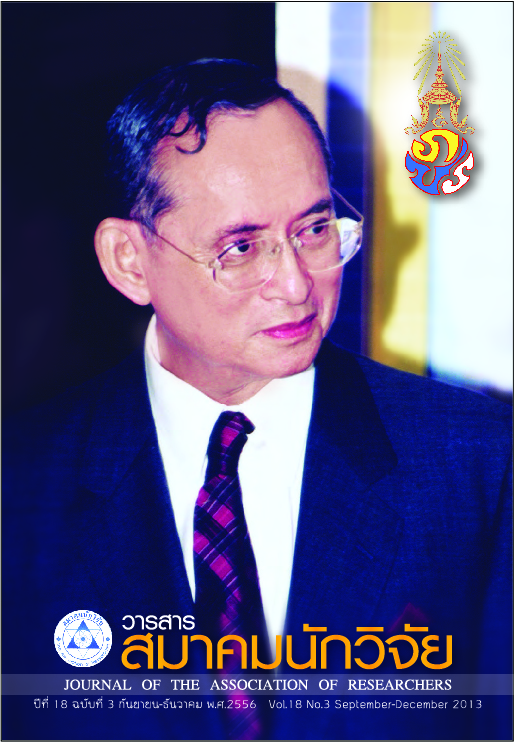Strategy for Personnel Development with the Action Research at Schools of the Consolidated Secondary School District 42, Ministry of Education.
Main Article Content
Abstract
The objectives of this study were to examine the managerial situations, to compare the managerial situations with school sizes, to analyze the factors of the managerial situation, and to present
the Strategy for Personnel Development with the Action Research (PDAR) at Schools of the Consolidated Secondary School District 42 (the CSSD 42), Ministry of Education. Data from teacher questionnaires (high validity and reliability) in schools at the CSSD 42, 953 subjects of all population 2,389 at 59 schools by multi-stage random sampling, and returning 777 subjects (85.39% of random sampling returned), were applied in this study. The following statistics were employed: Frequency, Percentage, Means, Standard Deviation, One-sample t-test with 80% criteria, Multivariate analysis of variance, and Factor analysis. Also, crucial results from factor analysis were developed as strategies for PDAR through the suggestion of 10 experts by the focus group discussion technique. Research results were as follows: 1) Managerial situations of PDAR at the CSSD 42), as a whole of each managerial category was at the
below the level of 80 percent, (p <.05). Those 5 categories were: organization, motivation, satisfaction on working practice, roles and mission (research), and research skills; 2) School sizes made the PDAR significant difference at the .05 level. It revealed that: (a) Organization category – teachers of schools in extra-large size (1) & moderate size (3) & small size (4) > large size (2), (b) Motivation category -teachers of schools in extra-large size (1) & moderate size (3) > large size (2) and small size (4), (c)Satisfaction on working practice - teachers of schools in extra-large size (1) & moderate size (3) >large size (2), (d) Roles and mission (research) - teachers of schools in extra-large size (1) & moderate size (3) > large size (2) & small size (4), and (e) Research skills - teachers of schools in extra-large size (1) > large size (2); 3) As a result of factor analysis, 25 from 81 variables (standardized factor
loads 0.273 to 0.444) as crucial variables were developed as strategies for PDAR at the CSSD 42; and
4) Completed strategies designed and developed by the researcher through the critique process with 10 experts consisted of 9 strategic issues of perspectives of Balanced Scorecard, and 14 initiative leading to practice with the operational plans within 3 years.
Article Details
บทความที่ปรากฏในวารสารนี้ เป็นความรับผิดชอบของผู้เขียน ซึ่งสมาคมนักวิจัยไม่จำเป็นต้องเห็นด้วยเสมอไป การนำเสนอผลงานวิจัยและบทความในวารสารนี้ไปเผยแพร่สามารถกระทำได้ โดยระบุแหล่งอ้างอิงจาก "วารสารสมาคมนักวิจัย"
References
จำรัส ปานฟัก (2555). “แบบแผนความคิดและพฤติกรรมผู้นำของหัวหน้าสถานีตำรวจในสังกัดตำรวจภูธรภาค 6,” วารสารสมาคมนักวิจัย, 17(1), (มกราคม – เมษายน), 81-89.
ชาติชาย ศรีแสง (2545). ปัจจัยที่ส่งผลต่อการทำวิจัยในชั้นเรียนของข้าราชการครูสังกัดกรมสามัญศึกษา จังหวัดขอนแก่น. วิทยานิพนธ์ศึกษาศาสตรมหาบัณฑิต มหาวิทยาลัยขอนแก่น.
บัญชา อึ๋งสกุล. (2537). บทบาทของผู้บริหารโรงเรียนมัธยมศึกษา ที่มีต่อการส่งเสริมการวิจัยในโรงเรียน มัธยมศึกษา สังกัดกรมสามัญศึกษาเขตการศึกษา 12. วิทยานิพนธ์การศึกษามหาบัณฑิต มหาวิทยาลัยศรีนครินทรวิโรฒประสานมิตร.
บุญช่วย ศิริเกษ. (2540). มนุษย์สัมพันธ์ในการบริหาร. เลย: คณะครุศาสตร์ สถาบันราชภัฏเลย.ผ่องพรรณ ตรัยมงคลกูล. (2544). การวิจัยในชั้นเรียน. กรุงเทพมหานคร: คณะศึกษาศาสตร์ มหาวิทยาลัยเกษตรศาสตร์.
พยุงศักดิ์ จันทรสุรินทร์. (2541). “การวิจัยในชั้นเรียน: ทางเลือกใหม่ของการนิเทศการสอนเพื่อพัฒนาคุณภาพการศึกษา,” วารสารวิชาการ, 1(8), 1- 2.
ลัสดา กองคำ. (2541). การศึกษาสภาพการวิจัยในชั้นเรียน เพื่อพัฒนาการเรียนการสอนในโรงเรียนมัธยมศึกษาขนาดใหญ่ สังกัดกรมสามัญศึกษา จังหวัดขอนแก่น. วิทยานิพนธ์ศึกษาศาสตรมหาบัณฑิต มหาวิทยาลัยขอนแก่น.
วีรพล ฉลาดแย้ม. (2544)” การวิจัยในชั้นเรียนของครูประถมศึกษา สานักงานการประถมศึกษาจังหวัดหนองบัวลำภู. วิทยานิพนธ์ศึกษาศาสตรมหาบัณฑิต มหาวิทยาลัยขอนแก่น.
สมพงษ์ เกษมสิน. (2521). การบริหาร. กรุงเทพมหานคร: สำนักพิมพ์ไทยวัฒนาพานิช.
สมศักดิ์ สินธุระเวชญ์. (2542). “การประกันคุณภาพการศึกษาของโรงเรียน.” ปฏิรูปการศึกษา, 1(2), 16-18.
สมหวัง พิธิยานุวัฒน์. (2534). “คุณภาพงานวิจัยเพื่อพัฒนาการศึกษา”. เอกสารการวิจัยทางการศึกษา อันดับที่ 107/2534. กองวิจัยทางการศึกษา กรมวิชาการ. (อัดสำเนา)
สริยา ทองสมัคร. (2538). สาเหตุในการทำและไม่ทำวิจัย และสภาพการทำวิจัยทางการศึกษาของครูมัธยมศึกษา สังกัดกรมสามัญศึกษา กระทรวงศึกษาธิการ เขตการศึกษา 3. กรุงเทพมหานคร: คณะศึกษาศาสตร์ มหาวิทยาลัยเกษตรศาสตร์.
สำนักงานการประถมศึกษาแห่งชาติ. (2542). ราชกิจจานุเษกษา ฉบับกฤษฎีกา (พระราชบัญญัติการศึกษาแห่งชาติ พ.ศ.2542). กรุงเทพมหานคร: โรงพิมพ์คุรุสภา ลาดพร้าว.
สำนักงานคณะกรรมการพัฒนาการเศรษฐกิจ และสังคมแห่งชาติ. (2550). แผนพัฒนาเศรษฐกิจและสังคมแห่งชาติ ฉบับที่ 10 พ.ศ. 2550-2554. กรุงเทพมหานคร: สำนักพิมพ์สูตรไพศาล.
สุทธนู ศรีไสย์. (2551). สถิติประยุกต์สำหรับงานวิจัยทางสังคมศาสตร์. พิมพ์ครั้งที่ 3. กรุงเทพมหานคร:คณะครุศาสตร์จุฬาลงกรณ์มหาวิทยาลัย.
Bontis, N. (1999). Managing an organizational learning system by aligning stocks andflflflflflfl ffllow flof knowledge: An empirical examination of intellectual capital, knowledge management and business performance. Dissertation Abstract International. Ontario: Ivey Business School, University of Western Ontario
Schuessler, K. F. (1964). Social research methods. Bangkok: Thammasart University, Thailand.
Schultz, T. W. (1971). Investment in human capital: The role of education and of research. New York: The Free Press.


